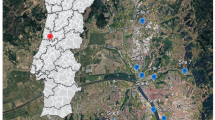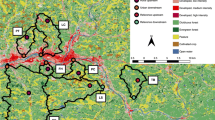Abstract
Andean rivers support an amazing biodiversity and provide important environmental services for Andean landscapes like water for agriculture and human consumption. Urban areas in Andean countries have grown at an accelerated rate in the last decades. As a consequence, a lack of wastewater treatment and riparian preservation have threatened these streams. We studied urban, agricultural, and well-preserved streams in the Upper Guayllabamba River Basin, where Quito, the capital city of Ecuador, is located. We found an aquatic insect richness loss of 78% in urban impacted streams. Urbanization extent within a watershed was strongly related to pollution and water quality decline, and aquatic insect community composition shifts to less diverse assemblages. Urban streams in Quito have lost most of their biodiversity and ecosystem services. However, they are important green areas for citizens and deserve better attention. Well-preserved streams in the area need protection since they host a rich biodiversity that we are starting to describe.




Similar content being viewed by others
Availability of data and material
Data is available in the text and supplementary material.
References
Acosta R, Rios B, Rieradevall M, Prat N (2009) Proposal for an evaluation protocol of the ecological quality of Andean rivers (CERA) and its use in two basins in Ecuador and Peru. Limnetica 28:35–64
Allan JD, Erickson DL, Fay J (1997) The influence of catchment land use on stream integrity across multiple spatial scales. Freshw Biol 37:149–161. https://doi.org/10.1046/j.1365-2427.1997.d01-546.x
APHA, AWWA, WEF (2012) Standard Methods for examination of water and wastewater. 22nd ed. Washington: American Public Health Association. 1360 pp. ISBN 978–087553–013–0
Bivins A, North D, Ahmad A et al (2020) Wastewater-Based Epidemiology: Global Collaborative to Maximize Contributions in the Fight Against COVID-19. Environ Sci Technol. https://doi.org/10.1021/acs.est.0c02388
Booth DB, Roy AH, Smith B, Capps KA (2016) Global perspectives on the urban stream syndrome. Freshw Sci 35:412–420. https://doi.org/10.1086/684940
Bremer L, Vogl AL, De Bièvre B, Petry P (2016) Bridging theory and practice for hydrological monitoring in Water Funds
Chang F-H, Lawrence JE, Rios-Touma B, Resh VH (2014) Tolerance values of benthic macroinvertebrates for stream biomonitoring: Assessment of assumptions underlying scoring systems worldwide. Environ Monit Assess. https://doi.org/10.1007/s10661-013-3523-6
Chiu T, Fang D, Chen J, Wang Y, Jeris C (2001) A robust and scalable clustering algorithm for mixed type attributes in large database environment. In Proceedings of the 7th ACM SIGKDD International Conference on Knowledge Discovery and Data Mining 2001, pages 263–268
Clarke KR, Gorley RN (2005) PRIMER 6: Getting started with v6. 1–12
Copernicus Sentinel data (2017) Retrieved from https://scihub.copernicus.eu/dhus/#/home 18th July 2018, processed by ESA
da Cruz E Sousa R, Ríos-Touma B (2017) Stream restoration in Andean cities: learning from contrasting restoration approaches. Urban Ecosyst. https://doi.org/10.1007/s11252-017-0714-x
Dominguez E, Encalada AC, Fernandez HR, Giorgi ADN, Marchese MR, Miserendino ML, Munne A, Prat N, Rios-Touma B (2021) Biomonitoreo en ríos de Argentina: un camino por recorrer. Ecol Aust 8–2021:934–949
Domínguez E, Fernández HR (2009) Macroinvertebrados bentónicos sudamericanos. Sistemática y biología. Fundación Miguel Lillo, Tucumán, Argentina, 656pp
Dominguez E, Molineri C, Pescador ML et al (2006) Ephemeroptera of South America. In: Ephemeroptera of South America. Pensoft Publishers
Donoso JM, Rios-Touma B (2020) Microplastics in tropical Andean rivers: A perspective from a highly populated Ecuadorian basin without wastewater treatment. Heliyon. https://doi.org/10.1016/j.heliyon.2020.e04302
ECLAC (2022) CEPALSTAT: databases and statistical publications. Economic Commission for Latin American and the Caribbean. https://statistics.cepal.org/portal/cepalstat/dashboard.html?indicator_id=1&area_id=1&lang=es. Accessed 8 Mar 2022
Eerkes-Medrano D, Thompson R (2018) Chapter 4 - Occurrence, fate, and effect of microplastics in freshwater systems. In: Zeng EYBT-MC in AE (ed). Elsevier, pp 95–132
Empresa Pública Metropolitana de Agua Potable y Saneamiento (2021) Programa para la descontaminación de los ríos de Quito. https://www.aguaquito.gob.ec/programa-para-la-descontaminacion-de-los-rios-de-quito/. Accessed 1 Mar 2021
Encalada AC, Flecker AS, Poff NL et al (2019) A global perspective on tropical montane rivers. Science 365:1124–1129. https://doi.org/10.1126/science.aax1682
European Commission (2000) Directive 2000/60/EC of the European Parliament and of the Council of 23 October 2000 establishing a framework for Community action in the field of water policy
Feio MJ, Hughes RM, Callisto M et al (2021) The Biological Assessment and Rehabilitation of the World’s Rivers: An Overview. Water 13:371. https://doi.org/10.3390/w13030371
Fernandez H, Dominguez E (2001) Guia para la determinacion de artropodos bentonicos sudamericanos
Guerrero-Latorre L, Ballesteros I, Villacrés-Granda I et al (2020) SARS-CoV-2 in river water: Implications in low sanitation countries. Sci Total Environ 743:140832. https://doi.org/10.1016/j.scitotenv.2020.140832
Guerrero-Latorre L, Romero B, Bonifaz E et al (2018) Quito’s virome: Metagenomic analysis of viral diversity in urban streams of Ecuador’s capital city. Sci Total Environ 645:1334–1343. https://doi.org/10.1016/j.scitotenv.2018.07.213
Hamada N, Thorp JH, Rogers C (2018) Keys to Neotropical Hexapoda: Thorp and Covich’s Freshwater Invertebrates. In Elsevier Academic press (Vol 3). Elsevier. 795 pp
Holzenthal RW, Ríos-Touma B, Rázuri-Gonzales E (2017) New species of the endemic Neotropical caddisfly genus Contulma from the Andes of Ecuador (Trichoptera: Anomalopsychidae). PeerJ. https://doi.org/10.7717/peerj.3967
Iñiguez-Armijos C, Leiva A, Frede HG, Hampel H, Breuer L (2014) Deforestation and benthic indicators: How much vegetation cover is needed to sustain healthy Andean streams? PLoS ONE. https://doi.org/10.1371/journal.pone.0105869
Iñiguez-Armijos C, Tapia-Armijos MF, Wilhelm F, Breuer L (2022) Urbanisation process generates more independently-acting stressors and ecosystem functioning impairment in tropical Andean streams. J Environ Manag. https://doi.org/10.1016/j.jenvman.2021.114211
Jost L (2006) Entropy and diversity. Oikos 113:363–375. https://doi.org/10.1111/j.2006.0030-1299.14714.x
Kirschner A, Kavka GG, Velimirov B, Mach RL, Sommer R, Farnleitner AH (2009) Microbiological water quality along the Danube River: Integrating data from two whole-river surveys and a transnational monitoring network. Water Res 43(15):3673–3684. https://doi.org/10.1016/j.watres.2009.05.034
Kvifte GM, Wagner R (2017) Psychodidae (sand flies, moth flies or owl flies). In Kirk-Spriggs AH, Sinclair BJ (eds) Manual of Afrotropical Diptera (Vol 5, pp 607–632). South African National Biodiversity Institute (SANBI Publishing)
Mara DD, Feachem RGA (1999) Water-and excreta-related diseases: unitary environmental classification. J Environ Eng 125:334–339
Ministerio del Ambiente Ecuador (2015) Tulsma. Ministerio del Ambiente, Ecuador, Quito, Ecuador
Moore AA, Palmer MA (2005) Invertebrate biodiversity in agricultural and urban headwater streams: Implications for conservation and management. Ecol Appl 15:1169–1177. https://doi.org/10.1890/04-1484
Myers N, Mittermeier RA, Mittermeier CG et al (2000) Biodiversity hotspots for conservation priorities. Nature 403:853–858
Oleas N, Ríos-Touma B, Altamirano PP, Bustamante MR (2016) Plantas de las quebradas de Quito: Guía Práctica de Identificación de Plantas de Ribera. Universidad Tecnológica Indoamérica
Ríos-Touma B, Acosta R, Prat N (2014) The Andean biotic index (ABI): Revised tolerance to pollution values for macroinvertebrate families and index performance evaluation. Rev Biol Trop 62:249–273
Ríos-Touma B, Holzenthal RW, Huisman J et al (2017) Diversity and distribution of the Caddisflies (Insecta: Trichoptera) of Ecuador. PeerJ 5:e2851. https://doi.org/10.7717/peerj.2851
Ríos-Touma B, Ramírez A (2019) Chapter 12 - Multiple stressors in the Neotropical region: Environmental impacts in biodiversity hotspots. In: Sabater S, Elosegi A, Ludwig R (eds) Multiple Stressors in River Ecosystems. Elsevier, pp 205–220
Rodriguez DJ, Serrano HA, Delgado A et al (2020) From Waste to Resource - Shifting paradigms for smarter wastewater interventions in Latin America and the Caribbean. Washington, D.C
Satterthwaite D (2003) The links between poverty and the environment in urban areas of Africa, Asia, and Latin America. Ann Am Acad Pol Soc Sci 590:73–92
Smith RF, Hawley RJ, Neale MW et al (2016) Urban stream renovation: Incorporating societal objectives to achieve ecological improvements. Freshw Sci. https://doi.org/10.1086/685096
Torremorell A, Hegoburo C, Brandimarte AL et al (2021) Present and future threats for the ecological quality management of South American freshwater ecosystems. Inl Waters. https://doi.org/10.1080/20442041.2019.1608115
Utz RM, Hilderbrand RH, Boward DM (2009) Identifying regional differences in threshold responses of aquatic invertebrates to land cover gradients. Ecol Indic 9:556–567. https://doi.org/10.1016/j.ecolind.2008.08.008
Villamarín C, Rieradevall M, Prat N (2020) Macroinvertebrate diversity patterns in tropical highland Andean rivers. Limnetica 39:677–691
Voloshenko-Rossin A, Gasser G, Cohen K et al (2015) Emerging pollutants in the Esmeraldas watershed in Ecuador: Discharge and attenuation of emerging organic pollutants along the San Pedro-Guayllabamba-Esmeraldas rivers. Environ Sci Process Impacts 17:41–53. https://doi.org/10.1039/c4em00394b
Walsh CJ, Roy AH, Feminella JW et al (2005) The urban stream syndrome: Current knowledge and the search for a cure. J North Am Benthol Soc 24:706–723. https://doi.org/10.1899/04-028.1
Walteros JM, Ramírez A (2020) Urban streams in latin america: Current conditions and research needs. Rev Biol Trop 68:S13–S28. https://doi.org/10.15517/RBT.V68IS2.44330
Acknowledgements
We are grateful with Francis Baquero who helped with the geographical analysis. Special thanks to Xavier Amigo and Nature Experience for its invaluable service during the sampling campaign. This manuscript was greatly improved by the comments and suggestions of 2 anonymous reviewers.
Funding
This work was supported by the Universidad de las Americas, Quito-Ecuador Projects AMB·BRT.17.01 and AMB.BRT.21.01, and was presented at the 5th Symposium of Urbanization and Stream Ecology thanks to a stipend from the US National Science Foundation Grant (award #2012128).
Author information
Authors and Affiliations
Contributions
Conceptualization: Blanca Ríos-Touma, Laura Guerrero-Latorre; Methodology: Blanca Ríos-Touma, Laura Guerrero-Latorre., Christian Villamarín, Gabriela Jijón, Genoveva Albuja-Granda, Jackie Checa, Edison Bonifaz; Formal analysis and investigation: Blanca Ríos-Touma, Laura Guerrero-Latorre, Gabriela Jijón, Genoveva Albuja-Granda, Jackie Checa, Edison Bonifaz; Writing—original draft preparation: Blanca Ríos-Touma; Writing—review and editing: Blanca Ríos-Touma, Christian Villamarín, Gabriela Jijón; Funding acquisition: Blanca Ríos-Touma, Laura Guerrero-Latorre; Supervision: Blanca Ríos-Touma, Laura Guerrero-Latorre.
Corresponding author
Ethics declarations
Ethics approval
No ethics approval was need for this study.
Consent to participate
This study did not involve humans.
Conflicts of interest/Competing interests
The authors have no conflicts of interest to declare that are relevant to the content of this article.
Environmental research permit
002–2017-IC-FLO-FAU-DPAP-MA issued by the Environmental Ministry of Ecuador.
Supplementary Information
Below is the link to the electronic supplementary material.
Rights and permissions
About this article
Cite this article
Ríos-Touma, B., Villamarín, C., Jijón, G. et al. Aquatic biodiversity loss in Andean urban streams. Urban Ecosyst 25, 1619–1629 (2022). https://doi.org/10.1007/s11252-022-01248-1
Accepted:
Published:
Issue Date:
DOI: https://doi.org/10.1007/s11252-022-01248-1




